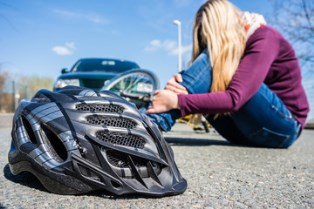Over 660 bicycle riders were injured in the Commonwealth of Virginia during 2015 (the most recent year for which complete statistics are available). Each of these injuries was unique, but many included broken bones. 
The Most Susceptible Bones in a Bike Accident
Without the protective metal of a motor vehicle, bicyclists are at risk of broken bone injuries. Any bone may break in a bike crash, including:
- Facial bones. A broken nose, a broken cheekbone, or even a chipped tooth can be painful and may require reconstructive surgery or result in disfigurement.
- Skull. A helmet may prevent many head injuries, but without a helmet, a head injury can be devastating.
- Neck. When one of the cervical vertebra between your skull and shoulders breaks, it is a serious injury. The broken vertebra may not adequately protect the spinal cord. If a spinal cord injury happens, paralysis or death can result.
- Back. A broken back creates the same dangers as a broken neck. If one of the vertebrae that’s supposed to protect the spinal cord breaks, the spinal cord is at risk of injury.
- Collarbone. If you are in pain and having difficulty moving your arm, a broken collarbone could be to blame. A broken collarbone is a common type of injury suffered in a bike crash.
- Ribs. Broken ribs can be painful and keep you out of work until the bones are healed.
- Arms and legs. A bike collision may cause you to fall at a bad angle and one or more of your limbs may be at risk for fracture.
- Hands and wrists. Bikers may put out their hands instinctively as they fall. However, the force of the collision may prevent their hands from stopping their fall effectively. Instead, one or more bones in the hands or wrist may break.
- Feet and ankles. A foot or an ankle that does not come off the pedal correctly or that is caught underneath the bicyclist, the bike, or a motor vehicle can fracture.
Some bikers suffer multiple broken bones from the same accident and are left with extensive medical bills and other damages because of their fractures.
Compensation After a Bicycle Accident
All drivers owe other motorists, pedestrians, and bicyclists a duty of care. If a motor vehicle driver was negligent, it is that driver who should pay damages for the bicyclist’s broken bone injuries. A driver is negligent if:
- The driver breached the duty of care by failing to act like a reasonable driver would in similar circumstances.
- The breach of the duty of care caused the bicyclist’s broken bones which would not have occurred but for the actions or inactions of the driver.
How to Protect Your Own Recovery
A broken bone injury can be significant. You may incur damages for your past, current, and future:
- Medical expenses. These include surgeries, casting, hospitalizations, doctor appointments, pain medications, physical therapy, and any other healthcare cost related to your injury.
- Lost income. Any wages, benefits, or income from self-employment that you can’t make because of your injury may be included in your recovery.
- Pain and suffering. Your physical pain and emotional suffering won’t go away with a financial recovery, but they are among your most significant damages, and you should be compensated.
- Out-of-pocket costs. Any other costs you incur as a direct result of your injury may be included in your recovery.
In order to establish liability and the value of your damages, you will have to present evidence and make convincing arguments to the insurance company with which you are negotiating a settlement or to the court. An experienced personal injury lawyer can help ensure the best legal recovery. For more information, please contact our experienced Fairfax injury lawyers today for a free and confidential case evaluation.
|
Related links: |

